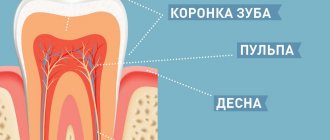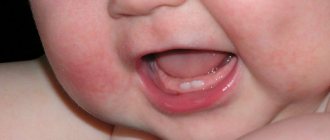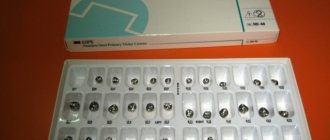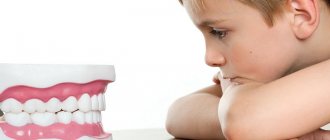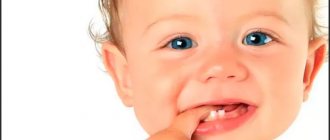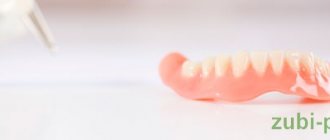An even bite has a significant impact on human health. It’s not for nothing that every mother is interested in the appearance and change of her child’s bite. Questions often arise when determining the type of tooth in a child’s mouth—whether it is a baby tooth or a molar.
A change in bite is accompanied by complications and it is necessary to understand their nature.
How many teeth should a child have?
Most parents do not monitor the growth of their child's teeth. If the process is painless. Moms and dads are repelled by the fact that their baby teeth will fall out in due course; this is a false statement. The process of replacing the bite needs to be monitored.
Complete eruption of baby teeth assumes completion in children at 2.5 years. By this age, the baby has grown 20 dental units, including:
- 8 incisors,
- 4 fangs,
- 8 molars.
There is a possibility that the baby may not have erupted 20 baby teeth. If there are more teeth than required, they have an awl shape and grow to the side. The lack of teeth is caused by the destruction of their rudiments during fetal development.
Why is tooth numbering necessary?
All human teeth have their own specific location according to numbers. But how can you understand whether it is located on the upper or lower jaw, or on the left or right? You can use full formulations (for example, the first permanent molar of the upper jaw on the right) But such cumbersome names create certain difficulties for dentists and can often cause mistakes, which are especially dangerous if the patient is undergoing extraction of a diseased tooth.
We invite you to familiarize yourself with White spots on the throat: causes and treatment. If they don't pass
In order to optimize the work of doctors and simplify the designation of tooth numbers as much as possible, special numberings were invented.
Classification of teeth
People define molars as permanent teeth. Although this concept refers to different categories. The following types are divided:
- Incisors are the teeth in front of the lower and upper jaws. They have a sharp edge and are used when biting off pieces of food.
- Fangs – have a thickened shape, allow you to tear apart dense food.
- Small molars (premolars) - located fourth and fifth in the dentition.
- Large molars (molars) - located farthest - 5,6, 8. Large teeth with a large chewing surface, like premolars, are designed for grinding pieces of food.
Such species can be milk-bearing, but in children, only the first and second molars erupt from the chewing ones. Trouble occurs directly with the molars when determining whether it is root or temporary.
On an ongoing basis
By the age of 6, the child’s first molars appear. The number of molars is 12, 6 for each jaw. The peculiarity of the upper molars is their large size and high strength. They have 3 roots that go in different directions. This ensures their reliable fastening and resistance to loads.
When a molar appears, the primary tooth naturally falls out. But sometimes there are exceptions. So, it happens that the milk has not yet fallen out, but permanent teeth are already ready to take their place.
In such cases, the child experiences pain and discomfort. In this case, it is better to immediately seek help from a specialist.
Timely assistance will prevent the new tooth from becoming crooked. Molars perform an important function, which is to crush food. This happens thanks to four tubercles on its surface.
They must be carefully looked after throughout their lives. This will preserve their integrity and functioning. Otherwise, you cannot do without the help of specialists.
When does teeth change?
Replacing primary teeth with permanent ones is considered an important step. Usually the latter erupt after the temporary ones fall out.
The timing of appearance may shift depending on the anatomical and physiological characteristics of each baby, climatic living conditions, and daily diet.
The classic change of bite involves the following sequence:
- primary molars appear in children 5-6 years old,
- then the main incisors of the lower jaw are replaced,
- at the same time, the upper and lateral incisors appear on the lower jaw,
- eight to nine years of age is accompanied by a change in the upper lateral incisors,
- up to 12 years of age, small molars are replaced,
- at the age of 13 the fangs change,
- around the age of 14, the second pair of molars appears, which are absent among the primary molars,
- After the age of 15, adolescents begin to erupt third molars, called “wise” teeth. At times they can remain in the gums until old age.
According to medical research, teeth in the lower jaw fall out first, then the upper jaw. Baby teeth change in a sequence similar to their appearance.
When and how do baby teeth appear?
It is believed that the first milk unit appears at 6 months, but the timing of eruption is an individual parameter. They are influenced by:
- genetic characteristics;
- course of labor;
- indicators of intrauterine development;
- constitution, physical parameters of the child;
- nutrition of the baby and mother (if the child is breastfed);
- climatic characteristics;
- quality of drinking water.
Children develop teeth at different times, but with the same sequence.
In regions with a hot climate, the timing of teeth appearance in babies is earlier than in regions where the weather is cold, but this relationship is not an axiom.
Parents will not be able to miss the appearance of the first units; this process is accompanied by severe symptoms :
- gums look swollen and red;
- salivation increases;
- children feel itching and try to scratch their gums with toys and fingers;
- the temperature rises to subfebrile levels.
In total, the child has 20 units: on each jaw there are 4 molars and incisors, and 2 canines.
How do babies' teeth grow? The sequence of appearance is shown in the table:
| Age (months) | Units |
| 6-8 | First lower incisors |
| 8-10 | First upper incisors |
| 9-12 | Second incisors (lower, upper) |
| 12-19 | First molars (upper, lower) |
| 17-20 | Upper canines |
| 18-22 | Lower canines |
| 20-36 | Indigenous (upper, lower) |
The first tooth should normally appear before the age of 1.5 years.
These dates may be subject to change. The normal situation is when at least one unit appears before the age of 1.5 years. If this does not happen, you need to look for reasons, which may include serious diseases - rickets and others. The examination begins with radiovisiography, which will allow you to see the rudiments of the teeth.
Congenital adentia is a rare phenomenon. Its cause is disruption of intrauterine development. Tooth germs are formed at 6-7 weeks, jaw formation - at 1.5-2 months. Infections, alcohol, taking medications, and smoking during these periods lead to problems.
How to distinguish a permanent molar from a milk tooth?
The change in bite occurs over time and ends around the age of 14. The rule does not include the third molars, the outer ones in the dentition, called “wisdom teeth.” They appear at an older age of 17-21 years and older.
There are cases when dental units remain under the gum surface without appearing on top of it. With an active change in occlusion, it is difficult for parents to remember which of the 20 primary teeth has been replaced and which has not.
Distinctive features will help to accurately determine the type of molar:
- The enamel shade of primary molars is white, while that of root molars is light yellow.
- The number of dental units – milk 20, permanent – 32.
- Volume and shape. Temporary molars are small in size and round in shape, while permanent molars are voluminous.
- Location – the eruption of baby teeth is carried out vertically, the permanent ones are directed with their crowns outwards towards the lips and cheek surface.
- Age of the child. The first dental units appear in 6-7 month old babies, permanent ones - at the age of 5-6 years.
- If the molar is the 6th or 7th, then it is a molar; the number of milk teeth on each side of the jaw can only be 5.
- The primary molar, in contact with the gum, forms a thickening.
- Milk teeth are represented by incisors, canines, and molars; permanent teeth additionally include premolars.
- The roots of milkweed are thin.
- The tubercles located on baby teeth are smooth, while on molars they are jagged.
Do you feel nervous before visiting the dentist?YesNo
When the type of tooth cannot be determined visually, an X-ray of the jaw should be taken. A permanent maxillary molar will have a triple root extending into the periosteum.
Constant units
The appearance of permanent units does not cause such problems. This is due to the fact that the gums are already ready for their eruption, and the roots of milkweeds - tortuous but thin - resolve painlessly. Main symptoms of change:
- Increasing spaces between milk jugs, starting before they wobble. This is due to the growth of the jaw, its preparation for the appearance of permanent units of a larger size.
- The milkmen begin to stagger. This is evidence of resorption of the roots, which is why they cannot hold steady.
- Redness of the mucous membrane and slight soreness of the gums are possible.
- The temperature usually does not rise, but low-grade fever occurs when a fang appears.
- Increased salivation occurs.
The main signal about an imminent change of teeth is an increase in the gap between milk jugs.
Like a child’s baby teeth, permanent teeth erupt at individual times. The norm is considered to be the beginning of the process at 6-7 years, the end – by 12-13 years. 20-25 years is the time when wisdom teeth appear, which not everyone has; their absence is also a variant of the norm. In this regard, an adult may have 28-32 teeth. Constant units are divided into two groups:
- Substitutes – having predecessors in the primary dentition.
- Additional – absent in the time series (premolars).
Prevention of improper eruption
The formation of baby teeth and their replacement is a natural phenomenon. Despite this, diseases or dietary difficulties can affect teething and provoke dental problems.
The following factors affect the change in bite:
- genetics. Hereditary predisposition affects the rate of formation of new ones, their shade, strength, bite,
- diet - the type of foods consumed, balance, the presence in the daily menu of the required amount of protein, minerals, fiber, which influence the change processes,
- the general well-being of the child, both physical and psychological. Illness, excessive physical activity, emotional stress can slow down teething,
- failure to comply with oral hygiene rules. The development of carious microorganisms causes dental pathologies that can lead to the removal of baby teeth. They hold space for the permanent ones; if removed early, the eruption of the permanent ones becomes difficult.
To keep your child’s smile snow-white as he grows up, teach him to perform hygiene procedures.
Possible dental pathologies in children
Among the diseases, two to three year old children develop caries. The destruction of dental units at an early age can cause complications, disruption of jaw development, and displacement of permanent molars. There may be an infection in the buds of the molars.
Replaced dental units can grow crookedly if the primary ones were straight. This is due to slow jaw growth. Due to lack of space, teeth begin to squint, protrude, and grow from above.
Possible threat of “shark teeth”. This happens when the molars begin to erupt before the mammary ones fall out. The situation with teeth that grow in the back row becomes serious. Then they resort to the help of an orthodontist. There are cases when the time has come to change teeth, but they do not appear. This may be due to physiological reasons, genetic, adentia.f
Possible difficulties during teething
The tooth breaks through the bone tissue and surrounding gum. This is a complex process that is accompanied by pain and can cause complications. The most common problem is fever, which may be accompanied by other symptoms:
- vomit;
- diarrhea;
- convulsions;
- loss of appetite.
Teething may be accompanied by fever.
If the above phenomena occur, you should consult a doctor. Teething may be accompanied by infection of the wound on the mucous membrane, manifested by similar symptoms. Other causes of infection are foreign objects in the mouth, weakened immunity, and changes in diet.
Other problems:
- An unpleasant odor resulting from partial decomposition of the mucous membrane.
- The yellowish tint is caused by the use of antibiotics by the child or mother during pregnancy.
- A greenish color indicates problems with the liver, a violation of bilirubin metabolism.
- Eruption outside the row due to a violation of the position of the tooth axis.
- An abnormal position caused by disturbances in the formation of the rudiment.
- Natal teeth formed in utero. They require observation: if they are well stable, they are not touched; if there is a danger of loosening and getting into the respiratory tract, they are removed.


